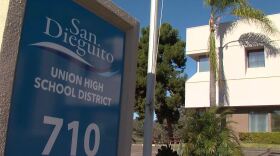On Saturday, October 18, tens of thousands of San Diegans gathered downtown for the second No Kings protest against the Trump administration. Organizers say 50,000 people showed up to the protest and march at Waterfront Park.
People from all over San Diego made their way downtown that day, and took lots of different routes to get there. But the public transit system saw a surge of riders that shows how large gatherings like that are boosted by having lots of transportation options.
On the day of the protest, SDMTS said they estimated 109,572 passenger trips were taken on the trolley system, versus 95,952 the previous Saturday.
That’s a 14% increase (although an MTS spokesperson did mention that Twitchcon was happening downtown that same day), and the agency ran additional service on the Blue and Green lines that day to accommodate the extra travelers.
NCTD's COASTER saw a 52% increase in ridership, with 3,765 boardings on the day of the protest versus 2,477 the previous Saturday, according to a spokesperson.
“It’s very clear when we want to have games at Petco Park, or any kind of gathering of people…that is what transit does,” said Dr. Lawrence Frank, professor of urban studies and planning at UCSD. “We rely on transit to make our cities function.”
Many people drove downtown that day, and the protest would have happened with or without the public transit system. But those transit options are a big reason that many people could efficiently move in and out of the area without causing major traffic jams or other issues.
Frank says even for people who did drive, the transit system meant fewer cars on the road – and that meant less time stuck in traffic.
“What would have happened was people would have found ways to get there by using the roadway system, which would have meant, if you were trying to get somewhere…when the rally is going to happen, you’re going to go nowhere,” Frank said. “The whole transportation system would collapse.”
Efficient transportation options are crucial to mobilizing lots of people for a mass movement like the No Kings protest, according to LaGina Gause, associate professor of Political Science at UCSD.
“By having an event in a location, like the No Kings protests, where there is accessible transportation, that increases the number of groups that are able to participate,” Gause said.
Gause says removing these barriers to participation, and making it easier to show up, is how mass movements can succeed. When huge numbers of people are gathering for the same cause, it has a wide-ranging impact.
“It’s not just … a sign of, people have been mobilized, but it’s also a sign that more potential mobilization and more potential organizing is possible,” Gause said.
It’s also a sign that lots of people are willing to take action for a cause.
“There’s been a demonstrated effect of protest participation leading to heightened participation in other activities, including voting behavior,” Gause said.
And seeing such large numbers of people gathering together for a cause can impact even those who didn’t participate.
“Seeing that many people shows them, ‘Hey, there's this many people who think the same way I do, or there's this many people who think differently than I do,’” Gause said. “And maybe that makes them think differently about what their preconceptions were.”
And UCSD’s Frank says that, in general, using public transit makes people more likely to support the foundation of equal rights on which the United States was built.
“Having more variation and exposure to people that are unlike ourselves, increases our comfort level and tolerance as individuals,” Frank said. “If we're only surrounded by people completely like ourselves, we continue to develop the perception that the whole world should be like us. And that makes us very inflexible, intolerant and uncomfortable, with people that look different, that behave differently, that have different cultural norms.”




